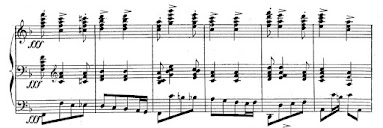For every hundred newly married
couples that requested Widor’s ‘Toccata’ from the local parish church organist,
I wonder how many had considered his ‘Marche Nupitale’. I concede that it does
not have the virtuosity of the well-known war horse but is it an impressive
piece that may be playable on a smaller instrument unsuited to the ‘big one.’
It is also great recessional piece that can be played irrespective of
occasion.
The ‘Marche Nupitale’ has quite a complex history. It began in 1885 when Widor produced the incidental music for the play Conte d’avril by the French dramatist and poet Auguste-Léon Dorchain (1857-1930). This was a comedy in four acts based on William Shakespeare’s Twelfth Night. The play was premiered on 22 September 1885 at the Odéon Théâtre, 2 rue Corneille, 6th arrondissement of Paris. In 1890, Widor extended the score considerably, and this was used in a large-scale revival of the play on 12 March 1891. It was a highly successful production. The score contained 18 pieces, including an ‘Overture’, three entr’actes and the present ‘Marche Nupitale’. The ‘Marche’ was a reworking of the third piece in the second edition of Six Duos, op.3 published c.1889 for piano and harmonium. The conductor Édouard Colonne extracted two ‘books’ or suites, for orchestra, op.64, designed for the concert hall. The first ‘Livre I’ included: ‘Ouverture’, ‘Sérénade illyrienne’, ‘Adagio’ and a ‘Presto’. The second, ‘Livre II’ featured: ‘Guitare’, ‘Appassionato’, ‘Romance’ and the ‘Marche nuptiale’. Widor wrote in his memoirs that ‘the entire score received a performance at the Châtelet concerts on November 15, 1891, under the direction of Colonne.’ (Near, 2011, p.207). Conte d’avril was also published in a version for two-pianos. To my knowledge, neither the incidental music, nor the suites have been recorded. Near (2011, p. 485, n138) notes that Widor and Mlle Berthe Max performed the piano suite in London for the benefit of a relief fund for ill-fated foreign artists living in England. 10 June 1892.
Finally, Widor transcribed the ‘Marche
nuptiale’ for organ in 1892[?]. It was published by H & C Heugel in the
same year.
The score suggests that a three manual organ is required – Recit, Postif, Grand-Orgue et Pedales. This relates roughly to the British Swell, Choir and Great and Pedals respectively. The composer calls for 8' and 16' pedal reed stops to be prepared, which many smaller instruments will lack.
The ‘Marche’ begins quietly and
slowly (andantino) in the solid key of F major with a relaxed exposition of the
main march tune:
The second theme is introduced in the subdominant key of Bb major. This is also quite easy-going. Relatively unusually for the organ, use is made of ‘spread chord in the right hand:
The formal structure of the
‘Marche’ consists of these themes played in alteration but varying in
figuration. The piece build up to a powerful conclusion, beginning with a
reprise of the opening theme with massive chords in octaves. This is
‘Recessional music to vie with the best.’ (Ateş Orga, 2016):
Bibliography:
Near, John R., Widor: A Life Beyond the Toccata. (Series: Eastman Studies in Music, v. 83. Rochester, NY: University of Rochester Press, 2011)
Orga, Ateş, Liner Notes for Signum Classics, SIGCD348 (2016)
Discography:
There are surprisingly few recordings of Widor’s ‘Marche nuptiale’ currently available. The first CD listed below was recorded on the famous Cavaillé-Coll of Saint-Sernin in Toulouse, On the Nolan disc, the Cavaillé-Coll of St François de Sales, Lyon was used.
- Widor, Charles-Marie, Complete Organ Works, Volume 7, Ben Van Oosten, MDG Gold 316 0519-2 (1998)
- Widor, Charles-Marie, Solo Organ Works, Joseph Nolan, Signum Classics, SIGCD348 (2017)



No comments:
Post a Comment